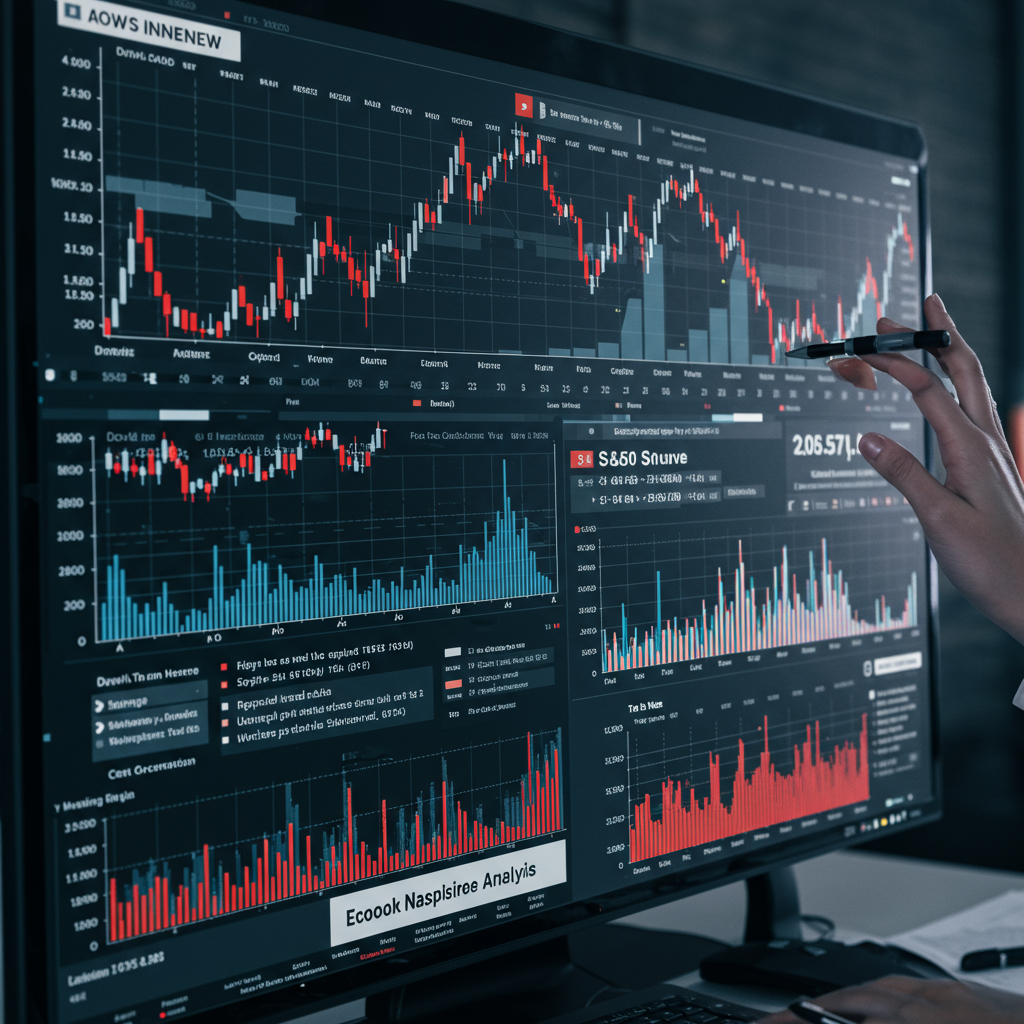Understanding the stock market today requires navigating a complex interplay of economic indicators, central bank policies, and corporate developments. Major indices like the Dow Jones Industrial Average, S&P 500, and Nasdaq Composite often react swiftly to breaking news, from pivotal employment figures to Federal Reserve pronouncements. For investors and observers alike, deciphering these daily movements is essential. This expert guide delves into the crucial factors shaping current market performance and offers insights into what to watch next.
The Federal Reserve’s Unseen Hand on Market Moves
The Federal Reserve’s decisions consistently stand as a primary driver for the US stock market. Investors constantly scrutinize every hint regarding interest rate policy. Anticipation of potential rate cuts, for instance, often fuels market optimism. Traders price in these expectations, with even subtle signals from Fed Chair Jerome Powell capable of swaying sentiment. His speeches, particularly at key events like the Jackson Hole symposium, are meticulously analyzed for clues about the future path of monetary policy.
Nominations to the Federal Reserve Board, such as Stephen Miran’s proposed appointment, also draw significant attention. New governors can influence the board’s overall hawkish or dovish leanings. Debates around the Fed’s independence, especially under political pressure, add another layer of uncertainty. Historically, prolonged periods of mega-cap stock dominance, like the one witnessed over the past decade, can shift. Analysts suggest that if the Fed eases monetary policy, a rotation towards value stocks might occur. This is because higher interest rates tend to penalize growth stocks more heavily. Broadening the S&P 500’s leadership beyond a few tech giants could redefine market dynamics.
Economic Data: Fueling or Dampening Investor Confidence
Economic reports provide a vital pulse check on the nation’s financial health, directly impacting the stock market today. Jobs data, in particular, is a powerful market mover. Reports like the ADP private payrolls, unemployment claims, and the comprehensive monthly jobs report offer critical insights. Weak employment figures, paradoxically, can sometimes be a positive for stocks. They may increase the likelihood of the Federal Reserve implementing interest rate cuts to stimulate the economy.
However, a persistently weak labor market, characterized by rising unemployment claims and individuals taking longer to find new work, signals deeper concerns. This can cool inflation but also points to a slowing economy. Beyond employment, manufacturing data, such as sustained contraction over several months, indicates broader economic challenges. These indicators force policymakers to weigh the risks of inflation against the need for economic growth. Goldman Sachs economists, for example, have noted a significant slowdown in trend job growth, warning of potential negative revisions.
Navigating Treasury Yields and Inflation Worries
Rising Treasury yields frequently act as a headwind for equities. When the 10-year or 30-year Treasury yields climb, especially nearing critical thresholds like 5%, they make bonds more attractive. This draws investment away from the stock market. Concerns about inflation, Federal Reserve independence, and the looming jobs report often exacerbate bond sell-offs. Historically, September has seen long-dated government bonds perform poorly due to portfolio rebalancing efforts. Investors constantly balance the allure of higher, risk-free bond returns against the potential for equity gains.
Geopolitics and Trade Policy: Global Market Shapers
Global events and trade policies significantly influence the US stock market. Tariffs, particularly those enacted by the U.S., can send ripples through international trade and corporate profits. Recent developments, including federal appeals court rulings on the constitutionality of certain tariffs, create considerable uncertainty. While some tariffs might ease corporate margin pressures, they also affect government revenue streams. The possibility of tariff carveouts, such as for companies manufacturing semiconductors domestically, can offer targeted relief to specific industries, like chip stocks.
Geopolitical tensions, such as US-Ukraine diplomatic meetings, can also impact commodity markets. Oil prices, for instance, might rise if peace talks stall and oil supply remains tight. Major international energy deals, like Russia’s pipeline agreement with China, can reshape global energy markets. These shifts can affect prices and supply chains worldwide, influencing corporate profitability and investor sentiment.
Corporate Earnings and Sector-Specific Dynamics
Company performance and sector trends are integral to the stock market today. Earnings season provides a crucial look into corporate health and consumer spending. Retail giants’ reports offer insights into consumer resilience and the impact of economic conditions. The tech sector, particularly the “Magnificent Seven” and AI-related stocks, garners intense scrutiny. Companies like Nvidia, despite robust growth, face questions about production scalability and “AI bubble” fears. Other AI data center operators also navigate a demanding market.
Elsewhere, companies face varied challenges and opportunities. Tesla’s stock reacts to global demand shifts, while gold prices soar amid Fed rate cut expectations and increased central bank holdings. Individual company news, from CEO dismissals to activist investor stakes (e.g., PepsiCo), can cause significant stock movements. The pharmaceutical industry, with breakthroughs in weight-loss drugs like Wegovy, sees substantial gains, though disappointing trial results for new treatments can lead to sharp declines. Even changes in tax credit guidance for sectors like residential solar can spur substantial rallies.
The Emerging Influence of Cryptocurrency
Cryptocurrency markets are increasingly tied to broader financial trends and regulatory developments, impacting the perception of the overall stock market today. Bitcoin and Ether, the largest digital assets, often react to Federal Reserve policy expectations. Profit-taking can lead to sharp pullbacks after significant rallies. Policy announcements, such as allowing alternative assets like cryptocurrencies into 401(k) retirement accounts, signal growing mainstream acceptance and can drive significant rallies in crypto-related stocks and digital assets. Furthermore, some Bitcoin miners are pivoting to provide AI infrastructure, signaling a convergence of these nascent technologies.
Market Outlook: AI’s Transformative Power and Strategic Shifts
Forecasting the stock market today involves considering both short-term volatility and long-term structural shifts. Strategists are increasingly bullish on the long-term outlook for indices like the S&P 500, often citing AI as a “once-in-a-generation technological shift.” This transformation is compared to the internet boom but with potentially faster and broader adoption across industries. AI is expected to boost corporate productivity and earnings, underpinning elevated market targets. However, some caution that an “AI-driven asset bubble” could form, especially if the Federal Reserve remains overly accommodative amidst lingering inflation.
Investment strategies are also evolving. The decade-long outperformance of mega-cap stocks may be nearing its end. A shift towards value stocks is anticipated, particularly if a “Recovery” phase emerges in the economic cycle. This broader participation across the market, rather than reliance on a few large companies, could create a more resilient investment environment.
Actionable Insights for Today’s Investor
For anyone navigating the dynamic stock market today, remaining informed is paramount. Understand that multiple factors simultaneously influence asset prices, from macroeconomics to micro-level corporate news. Diversifying your portfolio across various sectors and asset classes can mitigate risks associated with specific market downturns. Consider long-term trends, such as the transformative potential of AI, rather than reacting solely to daily fluctuations. Pay close attention to Federal Reserve communications and key economic data releases, as these often set the overall market tone.
Frequently Asked Questions
What are the main factors driving the US stock market today?
The US stock market is primarily driven by a combination of Federal Reserve monetary policy, key economic data (especially jobs reports and inflation), geopolitical developments like trade tariffs, and corporate earnings performance. Investor sentiment, influenced by these factors, also plays a crucial role in daily movements of the Dow Jones, S&P 500, and Nasdaq. Shifts in Treasury yields, indicating investor confidence in the broader economy, also heavily influence market direction.
How does Federal Reserve policy impact stock market performance?
Federal Reserve policy, particularly decisions on interest rates and quantitative easing, significantly impacts stock market performance. Lower interest rates generally make borrowing cheaper for companies and consumers, stimulating economic growth and making equities more attractive relative to bonds. Conversely, rate hikes can slow the economy and reduce corporate profitability. Speeches from the Fed Chair and nominations to the Board of Governors are closely watched for insights into future policy direction, directly influencing investor expectations and market activity.
Should investors adjust strategies based on current economic data and market trends?
Investors should consider adjusting their strategies based on current economic data and market trends, but with a long-term perspective. While daily market fluctuations driven by events like jobs reports or tariff news are common, significant shifts in Fed policy or broad economic indicators (like manufacturing contraction) may warrant re-evaluation of portfolio allocations. For instance, a potential shift from growth to value stocks, as highlighted by some strategists, might indicate a need to diversify beyond dominant mega-cap tech companies, especially if inflation persists and interest rates remain a factor.
The stock market today is a mirror reflecting a constant interplay of economic forces, policy decisions, and corporate narratives. From the nuanced signals of the Federal Reserve to the robust reporting of corporate earnings and the ever-present shadow of geopolitical events, every piece contributes to the market’s direction. Staying informed about these multifaceted drivers empowers investors to make more strategic and confident decisions in an ever-evolving financial landscape.




